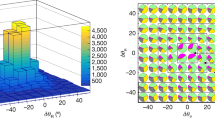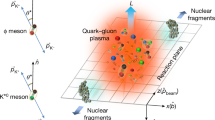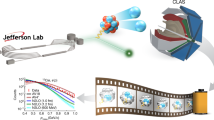Abstract
The axial coupling of the nucleon, gA, is the strength of its coupling to the weak axial current of the standard model of particle physics, in much the same way as the electric charge is the strength of the coupling to the electromagnetic current. This axial coupling dictates the rate at which neutrons decay to protons, the strength of the attractive long-range force between nucleons and other features of nuclear physics. Precision tests of the standard model in nuclear environments require a quantitative understanding of nuclear physics that is rooted in quantum chromodynamics, a pillar of the standard model. The importance of gA makes it a benchmark quantity to determine theoretically—a difficult task because quantum chromodynamics is non-perturbative, precluding known analytical methods. Lattice quantum chromodynamics provides a rigorous, non-perturbative definition of quantum chromodynamics that can be implemented numerically. It has been estimated that a precision of two per cent would be possible by 2020 if two challenges are overcome1,2: contamination of gA from excited states must be controlled in the calculations and statistical precision must be improved markedly2,3,4,5,6,7,8,9,10. Here we use an unconventional method11 inspired by the Feynman–Hellmann theorem that overcomes these challenges. We calculate a gA value of 1.271 ± 0.013, which has a precision of about one per cent.
This is a preview of subscription content, access via your institution
Access options
Access Nature and 54 other Nature Portfolio journals
Get Nature+, our best-value online-access subscription
$29.99 / 30 days
cancel any time
Subscribe to this journal
Receive 51 print issues and online access
$199.00 per year
only $3.90 per issue
Buy this article
- Purchase on Springer Link
- Instant access to full article PDF
Prices may be subject to local taxes which are calculated during checkout



Similar content being viewed by others
References
Detmold, W. Cold Nuclear Physics, USQCD Annual Progress Review to the US DOE https://www.usqcd.org/reviews/June2016Review/Talks/LQCD%20Rev16-USQCD_ColdNuclear_2016_Detmold.pdf (2016).
Bhattacharya, T. et al. Axial, scalar and tensor charges of the nucleon from 2+1+1-flavor lattice QCD. Phys. Rev. D 94, 054508 (2016).
LHPC Collaboration. Nucleon axial charge in full lattice QCD. Phys. Rev. Lett. 96, 052001 (2006).
Capitani, S. et al. The nucleon axial charge from lattice QCD with controlled errors. Phys. Rev. D 86, 074502 (2012).
Horsley, R. et al. Nucleon axial charge and pion decay constant from two-flavor lattice QCD. Phys. Lett. B 732, 41–48 (2014).
Bali, G. S. et al. Nucleon isovector couplings from N f = 2 lattice QCD. Phys. Rev. D 91, 054501 (2015).
Abdel-Rehim, A. et al. Nucleon and pion structure with lattice QCD simulations at physical value of the pion mass. Phys. Rev. D. 92, 114513 (2015); erratum 93, 039904 (2016).
Alexandrou, C. et al. Nucleon axial form factors using N f = 2 twisted mass fermions with a physical value of the pion mass. Phys. Rev. D 96, 054507 (2017).
Capitani, S. et al. Iso-vector axial form factors of the nucleon in two-flavour lattice QCD. Preprint at https://arxiv.org/abs/1705.06186 (2017).
Lin, H.-W. et al. Parton distributions and lattice QCD calculations: a community white paper. Prog. Part. Nucl. Phys. 100, 107–160 (2018).
Bouchard, C., Chang, C. C., Kurth, T., Orginos, K. & Walker-Loud, A. On the Feynman–Hellmann theorem in quantum field theory and the calculation of matrix elements. Phys. Rev. D 96, 014504 (2017).
Particle Data Group. Review of particle physics. Chin. Phys. C 40, 100001 (2016).
Aoki, S. et al. Review of lattice results concerning low-energy particle physics. Eur. Phys. J. C 74 2890 (2017).
Durr, S. et al. Ab initio determination of light hadron masses. Science 322, 1224–1227 (2008).
Borsanyi, S. et al. Ab initio calculation of the neutron-proton mass difference. Science 347, 1452–1455 (2015).
Weinberg, S. Phenomenological Lagrangians. Physica A 96, 327–340 (1979).
Gasser, J. & Leutwyler, H. Chiral perturbation theory to one loop. Ann. Phys. 158, 142–210 (1984).
Jenkins, E. E. & Manohar, A. V. Baryon chiral perturbation theory using a heavy fermion Lagrangian. Phys. Lett. B 255, 558–562 (1991).
Gasser, J. & Leutwyler, H. Spontaneously broken symmetries: effective Lagrangians at finite volume. Nucl. Phys. B 307, 763–778 (1988).
Symanzik, K. Continuum limit and improved action in lattice theories: (I). Principles and ϕ4 theory. Nucl. Phys. B 226, 187–204 (1983).
Berkowitz, E. et al. Möbius domain-wall fermions on gradient-flowed dynamical HISQ ensembles. Phys. Rev. D 96, 054513 (2017).
Bopp, P. et al. Beta-decay asymmetry of the neutron and g A/g V. Phys. Rev. Lett. 56, 919–922 (1986).
Yerozolimsky, B., Kuznetsov, I., Mostovoy, Y. & Stepanenko, I. Corrigendum: corrected value of the beta-emission asymmetry in the decay of polarized neutrons measured in 1990. Phys. Lett. B 412, 240–241 (1997).
Liaud, P. et al. The measurement of the beta asymmetry in the decay of polarized neutrons. Nucl. Phys. A 612, 53–81 (1997).
Mostovoi, Yu. A. et al. Experimental value of G A/G V from a measurement of both P-odd correlations in free-neutron decay. Phys. At. Nucl. 64, 1955–1960 (2001) [transl.]; Yad. Fiz. 64, 2040–2045 (2001).
Schumann, M. et al. Measurement of the proton asymmetry parameter in neutron beta decay. Phys. Rev. Lett. 100, 151801 (2008).
Mund, D. et al. Determination of the weak axial vector coupling λ = g A/g V from a measurement of the β-asymmetry parameter A in neutron beta decay. Phys. Rev. Lett. 110, 172502 (2013).
UCNA Collaboration. Precision measurement of the neutron β-decay asymmetry. Phys. Rev. C 87, 032501 (2013).
Alioli, S., Cirigliano, V., Dekens, W., de Vries, J. & Mereghetti, E. Right-handed charged currents in the era of the Large Hadron Collider. J. High Energy Phys. 5, 86 (2017).
Bazavov, A. et al. (MILC). Lattice QCD ensembles with four flavors of highly improved staggered quarks. Phys. Rev. D 87, 054505 (2013).
Acknowledgements
We thank C. Bernard, A. Bernstein, P. J. Bickel, C. Detar, A. X. El-Khadra, W. Haxton, Y. Hsia, V. Koch, A. S. Kronfeld, W. T. Lee, G. P. Lepage, E. Mereghetti, G. Miller, A. E. Raftery, D. Toussaint and F. Yuan for discussions. We thank E. Mereghetti for the updated Extended Data Fig. 729. We thank the MILC Collaboration for providing their highly improved staggered quark configurations30 without restriction. Computer time was awarded to CalLat (2016) by the Innovative and Novel Computational Impact on Theory and Experiment (INCITE) programme, as well as by the Lawrence Livermore National Laboratory (LLNL) Multiprogrammatic and Institutional Computing programme through a Tier-1 Grand Challenge award. This research used the NVIDIA GPU-accelerated Titan supercomputer at the Oak Ridge Leadership Computing Facility at the Oak Ridge National Laboratory, which is supported by the Office of Science of the US Department of Energy under contract number DE-AC05-00OR22725, the GPU-enabled Surface and RZHasGPU clusters, and Vulcan, a BG/Q supercomputer, all at LLNL. This work was supported by the NVIDIA Corporation (M.A.C.), the DFG and the NSFC Sino-German CRC110 (E.B.), an LBNL LDRD (A.W.-L.), the RIKEN Special Postdoctoral Researcher Program (E.R.), the Leverhulme Trust (N.G.), the US Department of Energy, Office of Science: Office of Nuclear Physics (E.B., C.B., D.A.B., C.C.C., T.K., C.J.M., H.M.-C., A.N.N., E.R., B.J., K.O., P.V. and A.W.-L.); Office of Advanced Scientific Computing (E.B., B.J., T.K. and A.W.-L.); Nuclear Physics Double Beta Decay Topical Collaboration (D.A.B., H.M.-C. and A.W.-L.); and the DOE Early Career Award Program (D.A.B., C.C.C., H.M.-C. and A.W.-L.). This work (E.B., E.R. and P.V.) was performed under the auspices of the US Department of Energy by LLNL under contract number DE-AC52-07NA27344. Part of this work was performed at the Kavli Institute for Theoretical Physics, supported by NSF grant number PHY-1748958.
Author information
Authors and Affiliations
Contributions
The project is managed by A.W.-L. and P.V. The computing allocation proposals were written by E.B., P.V., A.W.-L., T.K., A.N.N. and E.R. The Feynman–Hellmann-theorem-inspired method was implemented by K.O., A.W.-L., C.C.C., C.B. and T.K. The lattice action was designed by C.J.M., A.W.-L. and K.O. The QUDA MDWF solver was optimized by M.A.C. The integration of the QUDA MDWF solver to Chroma was implemented by T.K. and B.J. The HMC generation of new ensembles was done with MILC software (v7.8.0) by E.R. and A.W.-L. The implementation of the code for mixed mesons using MILC and Chroma was done by E.R., B.J. and A.W.-L. The calculations were performed by E.R., A.W.-L., E.B., C.C.C., A.N.N., D.A.B. and H.M.-C., using the job management software written by E.B. The non-perturbative renormalization was performed by D.A.B., H.M.-C., N.G. and A.W.-L. The correlator analysis was performed by C.C.C., A.N.N., A.W.-L., C.B. and C.J.M. The extrapolation analysis was performed by C.C.C. and A.W.-L.
Corresponding author
Ethics declarations
Competing interests
The authors declare no competing interests.
Additional information
Publisher’s note: Springer Nature remains neutral with regard to jurisdictional claims in published maps and institutional affiliations.
Extended data figures and tables
Extended Data Fig. 1 Correlator fit quality and stability.
a–c, Fit results for the effective mass (meff), axial (\({g}_{{\rm{A}}}^{{\rm{eff}}}\)) and vector (\({g}_{{\rm{V}}}^{{\rm{eff}}}\)) Feynman–Hellmann ratios overlayed on top of correlator data. The black and white filled data points are ground state values determined by subtracting the excited state contributions from the raw correlation functions under bootstrap resampling. d, The distribution of gA/gV after 5,000 bootstrap resamplings. The green-shaded regions correspond to the 68% (dark green) and 95% (light green) confidence intervals. All 5,000 bootstraps are shown, with no evidence of outliers. e, f, Stability of the correlation function analysis under varying tmin and tmax for meff, \({g}_{{\rm{A}}}^{{\rm{eff}}}\) and \({g}_{{\rm{V}}}^{{\rm{eff}}}\).The corresponding P values are shown in the bottom panel. The preferred simultaneous fit is highlighted by the solid black symbols. Uncertainties are one s.e.m.
Extended Data Fig. 2 Infinite-volume extrapolation of gA.
a, The three data points correspond to the a ≈ 0.12 fm and mπ ≈ 220 MeV ensembles with mπL = {5.36, 4.30, 3.25}. The next-to-leading order (NLO) finite-volume dependence predicted from the model-averaged extrapolation (to all 16 data points) is shown by the green band, with the central value indicated by the dashed green curve. b, Model-averaged extrapolation with finite-volume-adjusted data (coloured points). The central values of the raw data are denoted by a small black dash and, in all but one case, lie within one standard deviation of the finite-volume-adjusted result. Uncertainties are one s.e.m.
Extended Data Fig. 3 Continuum extrapolation of gA.
The nucleon axial coupling as a function of \({\varepsilon }_{{\rm{a}}}^{2}={a}^{2}/(4{\rm{\pi }}{w}_{0}^{2})\), where a is the lattice spacing and w0 is a hadronic length scale used to normalize LQCD calculations. The physical pion-mass limit is displayed by the magenta band, with the central value indicated by the dashed magenta curve. Additional curves with suppressed uncertainty bands are plotted for mπ ≈ 130 MeV (solid), mπ ≈ 220 MeV (dashed), mπ ≈ 310 MeV (dot-dashed), mπ ≈ 350 MeV (dotted) and mπ ≈ 400 MeV (dot-dot-dashed). Uncertainties are one s.e.m.
Extended Data Fig. 4 Model extrapolation plots.
a, Model-averaged extrapolation of gA as a function of επ, determined as described in Supplementary Information (section S.7A). b, Determination of gA at the physical point from the model-averaging procedure. The magenta histogram is the final determination of gA, constructed from a weighted average of the various models used in the extrapolation, which appear as the distributions lying inside the final histogram. c–h, The resulting extrapolation of gA as a function of επ for each of the six models used in the averaging procedure (see Supplementary Information, section S.6). The magenta band is the resulting 68% confidence interval of the continuum, infinite-volume extrapolated value of gA as a function of επ. The red, green and blue curves are the central values of gA versus επ at fixed lattice spacings of 0.15 fm, 0.12 fm and 0.09 fm, respectively. Uncertainties are one s.e.m.
Extended Data Fig. 5 Stability and convergence of the chiral–continuum extrapolation.
In the left panel, the model-averaged result (‘model avg’) is the black square. The vertical magenta band is the resulting 68% confidence band. The next six values are results from individual extrapolations that go into the model average, described in Supplementary Information, section S.7A. Uncertainties are one s.e.m. ‘ct’, counter-term; ‘FV’, finite volume; ‘disc.’, discretization; αS = g2/(4π), where g is the quark–gluon coupling of QCD. The middle panel shows the augmented χ2 (\({\chi }_{{\rm{a}}{\rm{u}}{\rm{g}}}^{2}\)) per degree of freedom (dof), where \({\chi }_{{\rm{a}}{\rm{u}}{\rm{g}}}^{2}\) is the sum of the χ2 values from the data and from the priors. All fits have 16 degrees of freedom because each prior is counted as a data point. The right panel shows the resulting Bayes factors normalized by the NLO Taylor \({\varepsilon }_{{\rm{\pi }}}^{2}\) Bayes factor, which is found to be the largest among them. These normalized Bayes factors are used as relative weights in the model-averaging procedure. The stability of the extrapolation analysis is tested by including additional discretization terms, omitting the predicted NLO finite-volume corrections, increasing the prior widths on the leading order (LO) and all low-energy constants, and applying cuts on the pion masses considered and on the discretization scales included. All variations are contained within 1σ of the model-average value, with most being substantially smaller than 1σ from the central value. Finally, we show the resulting extrapolation from the complete next-to-next-to-next-to-leading order (N3LO) chiral perturbation theory analysis and from the NLO chiral perturbation theory analysis with ∆ degrees of freedom (χPT(∆)). The N3LO fit is not included in the average because it has five unknown low-energy constants and we have only five different pion mass values. The NLO χPT(∆) value is not included because it requires input from phenomenology and is thus not a pure lattice QCD prediction, and also the next-to-next-to-leading order (NNLO) χPT(∆) extrapolation function is not known, so a test of stability and convergence is not possible.
Extended Data Fig. 6 Convergence of gA.
a–f, Order-by-order contribution to the extrapolation of gA for the six different models that enter in the final model-averaged result (see Supplementary Information, section S.6). The low-energy constants are determined by the full fit from each model. Higher orders are added successively, producing the final reconstruction of the extrapolation when all contributions up to a given order are included.
Extended Data Fig. 7 Constraint on right-handed beyond-standard-model currents.
Measurements of cold neutron decays (\(n\to p{e}^{-}\bar{\nu }\); n, neutron; p, proton; e−, electron; \(\bar{\nu }\), antineutrino) provide some of the most stringent constraints on new physics. A recent comparison of constraints from low-energy experiments and colliders found comparable constraints on right-handed beyond-standard-model currents29. The figure has been adapted from figure 12 of ref. 29 using our determination of gA. The vertical orange band is the constraint on the right-handed coupling (ξ ud ) from our result. The blue circle arises from collider constraints on W- and Higgs-boson production (WH) at collision energy \(\sqrt{S}=14\,{\rm{TeV}}\), and the diagonal red band is from pion decays (long direction; π → μ\(\bar{\nu }\), where μ is a muon) and super-allowed 0+ → 0+ nuclear decays, which constrain corrections to the axial (left (δV ud ) minus right) and vector (left plus right) currents, respectively.
Supplementary information
Supplementary Information
This file contains supplementary information S1-S8, supplementary figures S1-S27 and supplementary tables 1-6.
Rights and permissions
About this article
Cite this article
Chang, C.C., Nicholson, A.N., Rinaldi, E. et al. A per-cent-level determination of the nucleon axial coupling from quantum chromodynamics. Nature 558, 91–94 (2018). https://doi.org/10.1038/s41586-018-0161-8
Received:
Accepted:
Published:
Issue Date:
DOI: https://doi.org/10.1038/s41586-018-0161-8
This article is cited by
-
Constraints on subleading interactions in beta decay Lagrangian
Journal of High Energy Physics (2024)
-
Anomalies in global SMEFT analyses. A case study of first-row CKM unitarity
Journal of High Energy Physics (2024)
-
Constraints on ultralight scalar dark matter with quadratic couplings
Journal of High Energy Physics (2023)
-
Alpha-alpha scattering in the Multiverse
Journal of High Energy Physics (2022)
-
Status, challenges and trends of data-intensive supercomputing
CCF Transactions on High Performance Computing (2022)
Comments
By submitting a comment you agree to abide by our Terms and Community Guidelines. If you find something abusive or that does not comply with our terms or guidelines please flag it as inappropriate.



